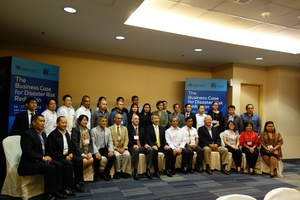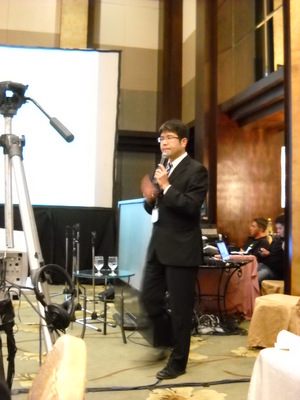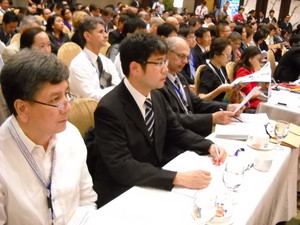Activity Report
30 June to 2 July 2014 (Toulouse, France)
ADRC participated in the Toulouse Space Show held in Toulouse, France on 30 June to 2 July 2014. This show was organized by the Centre National d'Etudes Spatiales (CNES), and featured displays and introductions to activities by space-related organizations and companies from across Europe. Meetings were held to discuss the effective use of space technologies in various fields such as telecommunications and policymaking. ADRC participated in a roundtable discussion on "Crisis Management and Mitigation: Anticipating, Managing, and Rebuilding" and shared good practices in the use of space technologies during the Great East Japan Earthquake. Other organizations including the United Nations Office for Outer Space Affairs (UNOOSA) and the German Aerospace Center (DLR) also gave presentations on their latest activities in this field and explained the need for cooperative structures that extend beyond national and regional boundaries.
(2014/07/22 18:30)
22-27 June 2014 (Bangkok, Thailand)
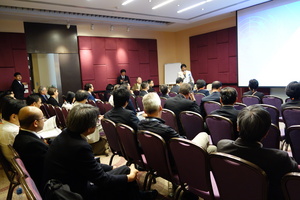 On occasion of the Sixth Asian Ministerial Conference on Disaster Risk Reduction (6AMCDRR), a biennial conference in Asia to ensure political and stakeholder's commitment towards disaster risk reduction implementation, the International Recovery Platform (IRP) organized a side event
On occasion of the Sixth Asian Ministerial Conference on Disaster Risk Reduction (6AMCDRR), a biennial conference in Asia to ensure political and stakeholder's commitment towards disaster risk reduction implementation, the International Recovery Platform (IRP) organized a side event
"Investing in Recovery for Resilience: Articulating Recovery in HFA2" was organized on June 24, 2014 at Lotus 4, Bangkok Convention Center at Centara Grand. Following the opening and special remarks by Mr. Kaoru Saito, Director of Cabinet Office, Japan, with panelists coming from diverse backgrounds, including Atty. Violeta Seva of Makati City (Philippines), Prof. Santosh Kumar of SAARC Disaster Management Center (SDMC), Mr. Tadao Hasue and Ms. Kumi Onuma of Development Bank of Japan (DBJ), and Ms. Ana Cristina Thorlund of International Recovery Platform (IRP), past experiences were highlighted to draw insights. The moderator Mr. Saber Hossain Chowdhury, Member of Parliament Bangladesh, raised the broad question: What will be the critical recommendations to adequately articulate recovery in HFA2?
After consolidating all the inputs from speakers and audience, the side event came up with the following key recommendations:
- Institutionalizing recovery functions in national and local governance systems
- Ensuring financial predictability for recovery programs and activities
- Strengthening coordination of recovery actors as well as considering the trans- boundary nature of recovery
- Recognizing human security as an essential foundation for effective recovery
- Developing concrete and measurable indicators to monitor progress of implementation and achievement of recovery goals
In view of these recommendations, it was suggested that the future role of IRP may consider acting as a global mechanism for cooperation in the areas of recovery. Its task may include providing technical support on recovery for subnational governments, contributing to achieve sustainable development goals (SDGs), offering technical support on recovery from technological disasters or conflicts, and ensuring seamless integration of recovery in with development plans.
Three key conclusions were reached at the end of the session. Firstly, recovery should be adequately articulated in HFA2 so that governments can have general guidance in implementing recovery programs. Secondly, recovery (seen as an opportunity to build back better) must also be aligned with the sustainable development goals. Finally, recovery needs further advocacy at the policy and legislative levels to outline clear measures for monitoring progress as well clear roles of government departments and units in implementing recovery programs.
The event was concluded successfully with the closing remarks by Mr. Kiyoshi Natori, Executive Director of ADRC.
The IRP booth showcased various knowledge products including Guidance Notes on 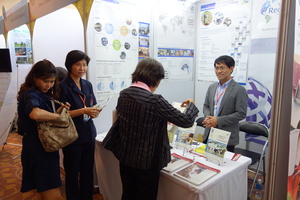 Recovery, newsletters, thematic reports, brochures, and materials on recovery from IRP partners. In addition, the works and activities of IRP are presented in attractive posters that caught the attention of many delegates at the conference. the Secretariat pursued wider dissemination of IRP products and services as well as building and strengthening partnerships.
Recovery, newsletters, thematic reports, brochures, and materials on recovery from IRP partners. In addition, the works and activities of IRP are presented in attractive posters that caught the attention of many delegates at the conference. the Secretariat pursued wider dissemination of IRP products and services as well as building and strengthening partnerships.
Following the 6AMCDRR, the IRP Secretariat participated in the workshop on "Job-rich Recovery after Natural Disasters: Lessons from the Great East Japan Earthquake" organized by ILO Asia-Pacific Office on 27 June 2014 at the United Nations Convention Center in Bangkok.
The objectives of the workshop included raising awareness of the relevance of employment and social protection policies in the contexts of disaster risk prevention and post-disaster reconstruction; sharing experiences, lessons, and good practices generated from the reconstruction process in Japan since the 2011 Great East Japan Earthquake; and identifying strategies for further enhancing knowledge on job-rich disaster risk prevention and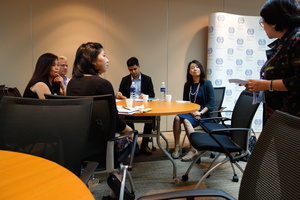 reconstruction practice in Asia and the Pacific. The participants who attended the workshop were experts and practitioners in employment policy, social protection, and disaster risk management from selected governments, humanitarian, and development assistance organizations in Asia and the Pacific.
reconstruction practice in Asia and the Pacific. The participants who attended the workshop were experts and practitioners in employment policy, social protection, and disaster risk management from selected governments, humanitarian, and development assistance organizations in Asia and the Pacific.
(2014/07/02 14:40)
22-27 June 2014 (Bangkok, Thailand)
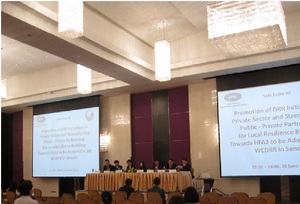 The Asian Disaster Reduction Center (ADRC) participated in the 6th Asian Ministerial Conference on Disaster Risk Reduction (6th AMCDRR) held in Bangkok, Thailand from 22 to 26 June 2014. The conference participants included more than 3,000 delegates, ministers, and top government officials, as well as UN agencies, international organizations, and NGOs. The objectives of this conference were to generate stronger political commitment for and investments in disaster risk management among the nations of Asia, and to stimulate discussions around the formulation of a post-2015 framework for DRR in preparation for the upcoming 3rd WCDRR to be held in Sendai, Japan. ADRC also helped arrange several side events and facilitated a pre-conference meeting as follows.
The Asian Disaster Reduction Center (ADRC) participated in the 6th Asian Ministerial Conference on Disaster Risk Reduction (6th AMCDRR) held in Bangkok, Thailand from 22 to 26 June 2014. The conference participants included more than 3,000 delegates, ministers, and top government officials, as well as UN agencies, international organizations, and NGOs. The objectives of this conference were to generate stronger political commitment for and investments in disaster risk management among the nations of Asia, and to stimulate discussions around the formulation of a post-2015 framework for DRR in preparation for the upcoming 3rd WCDRR to be held in Sendai, Japan. ADRC also helped arrange several side events and facilitated a pre-conference meeting as follows.
[Side Event (SE7): Introduction and Demonstration of the DRR Education Tools and Efforts for Getting Wider Participation of Communities]ADRC conducted a side event entitled "Introduction and Demonstration of the DRR Education Tools and Efforts for Getting Wider Participation of Communities"" on 23 June 2014 during the 6th AMCDRR. The session aimed to introduce good practices in CBDRM, highlighting disaster education tools that have been promoted by local NGOs and local governments since the 1995 Great Hanshin-Awaji Earthquake. It also focused on efforts to raise DRR awareness and training programs for local government officials based on lessons learned from that earthquake. The side event was also intended to facilitate discussions around how to localize such tools and efforts in other countries, and it highlighted some successful localization activities from Asia and other parts of the world. After the introduction by ADRC, Mr. Masahiko Murata from the Disaster Reduction and Human Renovation Institution (DRI), Mr. Nobuhito Ohtsu of the Kobe City Fire Bureau, and Dr. Ikaputra of Gadjah Mada University introduced their DRR efforts, all of which are based on lessons learned from the Great Hanshin-Awaji Earthquake. First, Mr. Murata of DRI gave a presentation entitled "Hyogo Prefecture's Effort for Capacity Development of Local Government Officials and Raising Awareness of the Public"" in which he introduced the training programs targeting mayors, local government officials, and local residents, as well as efforts to raise public awareness. Mr. Ohtsu of Kobe City next explained "BOKOMI," a community-based disaster risk management organization that has been promoted by Kobe City since the Great Hanshin-Awaji Earthquake. He emphasized the importance of self-self and mutual-help, in addition to public help.After these two presentations, Dr. Ikaputra of Gadjah Mada University described an example of how disaster education tools have been adapted to Yogyakarta, Indonesia. "Iza! Kaeru Caravan!" is a Japan-based disaster education and awareness raising program for children that was developed by NPO Plus Arts based in Kobe. He localized the tool and conducted the program in Indonesia, ensuring close coordination between Plus Arts and the local residents of Yogyakarta. He concluded his presentation by stressing the need for disaster education for children, as well as the importance of ensuring the beneficial application of various tools within local contexts. Lastly, Mr. David Korunic of AXA Group introduced an example of how CBDRM has been promoted by the private sector and NGOs, explaining AXA-CARE International's joint initiative for building disaster resilience in local communities in Thailand and the Philippines. At the end of the session, all the participants confirmed that there is a need for the development of good educational tools for CBDRM which are based on past experience as well as local contexts. They also highlighted the need for the well-coordinated localization of tools, as well as the benefits of involving the private sector and various stakeholders in CBDRM activities.
[Side Event (SE40): Promotion of DRR Initiatives in Private Sector and Strengthening Public - Private Partnership for Local Resilience Building : Towards HFA2 to be Adopted in 3rd WCDRR in Sendai]On 25 June 2014, ADRC and the APEC Emergency Preparedness Working Group (EPWG) co-chaired a Side Event entitled " Promotion of DRR Initiatives in Private Sector and Strengthening Public-Private Partnership: for Local Resilience Building: towards HFA2 to be Adopted in 3rd WCDRR in Sendai " Experts from ADRC, APEC EPWG, Sendai City, the Development Bank of Japan, JICA, and Mitsubishi Corporation Insurance gave presentations on their good practices related to the these subjects. Dr. Wei-Sen Li from the APEC Emergency Preparedness Working Group gave a presentation on surveys on BCP status, BCP Guidelines for SMEs, and relevant training activities in the APEC region. Sendai City Vice Mayor, Mr. Yukimoto Ito introduced projects involving collaboration with the private sector, civil society organizations, and communities such as disaster-resilient town planning and the formation of agreements with the private sector regarding logistics and evacuation in times of disaster. Sendai City was recognized as a Role Model in the 2010-2015 World Disaster Campaign "Making Cities Resilient" and will host the 3rd UN World Conference on Disaster Risk Reduction in March 2015. Mr. Tadao Hasue, Deputy General Manager, and Ms. Kumi Onuma, Associate, Tohoku Branch, Development Bank of Japan gave a presentation on their region-wide plans and activities targeting the Tohoku Region including the establishment of the Tohoku Alliance, a Tohoku‐based platform for a flexible alliance among diverse entities in Japan and abroad for knowledge and information sharing. JICA Senior Advisor Dr. Hitoshi Baba introduced JICA's new concepts of "Area BCP" and "Area BCM," which refer to a scalable cross-sector coordination framework for disaster management for business continuity. He also outlined how these are being applied in a pilot project in industrial clusters in the ASEAN region. Mr. Takahiro Ono of Mitsubishi Corporation Insurance then commented on the importance of improving disaster resilience of both private sector enterprises and local governments, and on strengthening community-wide networks to ensure that the best actions are taken. Finally, ADRC Executive Director Mr. Kiyoshi Natori summarized the discussions to conclude the event.
[Pre-Conference (PC-8): Satellite Data and Information to Supplement Regional and National DRR Systems and to Assist Local Communities at Risk]On 22 June 2014, JAXA and ADRC cooperated in organizing a pre-conference entitled "Satellite Data and Information to Supplement Regional and National DRR Systems and to Assist Local Communities at Risk." The purpose of this event was to share information on how satellite data and information are being used for DRR, to investigate user needs, and to promote the expansion of cooperative structures among operators, governments, and communities with regard to the collection and use of satellite data. This pre-conference was divided into two sessions.The first session was on "Progress and Issues with Existing Regional and National (Coordination and Management) Initiatives and Related Access Mechanisms." Dr. Lal Samarakoon from AIT showed outcomes of the space technology session at ACDR 2014 which was held in Tokyo in March. Dr. Shirish Ravan from UNOOSA also reported on the outcomes of the ASEAN workshop, given its position as a UN-SPIDER activity. ADRC reported on regional DRR requirements and activities. Mr. Pierre-Henri Pisani from the Embassy of France in Japan explained the latest efforts in the development of an international charter to promote the use of space technologies worldwide. Dr. Sanjay Kumar Srivastava from UNESCAP mentioned harnessing regional cooperation for enhancing national capacity for disaster risk management. And representing JAXS, Mr. Chu Ishida introduced the Sentinel Asia evolution and space agencies' recommendations for HFA2. He also announced that a new satellite, the ALOS2 was launched in May 2014.The second session was on "Working with Communities at Risk: Initiatives and Projects Devoted to the Use of Earth Observations for the Benefit of Local Communities." Good practices in the use of space technologies in DRR were reported on by Tajikistan, China, Bangladesh, and the Philippines. Professor Shunichi Koshimura from Tohoku University gave a presentation on the analysis and use of satellite images during the Great East Japan Tsunami. Mr. Hiroshi Une from the Geospatial Information Authority of Japan introduced some of the basic data developed by that organization and proposed ways that it might be developed for the DRR field. Professor Ryosuke Shibasaki from the University of Tokyo explained the use of big data and space technology for DRR. This pre-conference was tied to the morning pre-conference which was organized by UN-SPIDER. Both organizers put together a proposal on the importance of investing in the systematic generation of products based on space-based and geospatial information.
Final Plenary Session and the "Bangkok Declaration"At the plenary session held on the final day of the conference, participants adopted the "Bangkok Declaration" to conclude the event. Its policy recommendations to nations and stakeholders are as follows:1. Enhance resilience at local levels2. Improve public investment in disaster and climate risk management to protect and sustain development gains3. Promote public and private partnerships for DRR4. Promote science and technology5. Enhance governance, transparency, and accountability6. Contribute to the global deliberation on the Post-2015 Framework for Disaster Risk Reduction and the development of an Asia-Pacific Regional HFA2 Implementation Plan7. Ensure that the Post-2015 Framework for DDR is consistent with sustainable development goals and climate change efforts
(2014/06/22 18:30)
16-17 June 2014 (Manila, Philippines)
Hosted by SM Prime and led by UNISDR's Global Education Training Institute (GETI) and with the support of the International Recovery Platform (IRP), a two-day workshop on the "Business Case for Disaster Risk Reduction" was held at SMX Convention Center ? Mall of Asia, Manila Philippines, 16-17 June 2014.
The workshop was conceptualized in recognition of the rapid change in global economic and political arena, where there is an increasing interconnectedness of global trade, financial markets, and supply chains. In this context, the world of business is facing a more risky environment ? especially when a disaster strikes. For instance in 2011, the Great East Japan Earthquake and the flooding in Bangkok have shown how the private sector was heavily impacted. Essentially, global players need to protect and ensure that businesses continue after a disaster. The business case for DRR implies: (i) strengthening private sectors' capacities and strategies for risk management; (ii) ensuring prudence and sustainability in investments through regulatory and voluntary actions to increase the visibility of all risks; and (iii) encouraging government to invest more heavily in DRR in partnership with the private sector.
With over 60 participants from the business enterprises, governments, and academia, the workshop included group discussions on what strategies and actions can be put forward to further build resilience in business. IRP/ADRC presented global case studies on small enterprises and DRR to provide guidance and wider options for participants in drafting their respective business continuity plans (BCPs). Local experiences were also presented by distinguished personalities in the Philippines including Mr. Hans Sy (President SM Prime), Mr. Alexander Pama (Executive Director NDRRMC), Mr. Renato Solidum (Director PHIVOLCS), Mr. Jose Cadiz (Vice Mayor Marikina City), and Mr. Alfredo Arquillano Jr. (Former Mayor San Francisco, Cebu Province).
The workshop came up with recommendations to address knowledge gaps on DRR and convince business owners to move beyond basic business continuity planning through partnerships and closer collaboration between public and private sector. Additionally, it was recommended that businesses shall also consider the opportunity to create value in markets with products that address disaster risk.
(2014/06/30 14:40)
 4-5 June 2014 (Gabala, Azerbaijan)
4-5 June 2014 (Gabala, Azerbaijan)
ADRC has participated in the 7th ECO (Economic Cooperation Organization) International Conference on Disaster Risk Management held in Gabala, Azerbaijan on 4-5 June 2014. This conference was organized by the Ministry of Emergency Situations of Azerbaijan, together with ECO Secretariat. This conference provided the delegates of ECO Member States and experts from UN agencies, international organizations and academic and scientific institutions to discuss and share experiences on disaster risk reduction for better cooperation in the ECO region. In the ECO Member States, Azerbaijan, Iran, Kazakhstan, Kyrgyz Republic, Pakistan, Tajikistan, and Uzbekistan are the ADRC's member countries.
Following the presentations and speeches from the heads of delegations, various organizations such as UNOCHA, UNESCAP, GIZ, Central Asian Institute for Applied Geosciences (CAIAG) and ADPC, etc. introduced their efforts for disaster risk reduction in the region. ADRC made a presentation on its roles in Asia, as well as the programs that member countries from Central and Caucasus can be benefitted, namely the Visiting Researcher Program, the JICA training for Central Asia and Caucasus, and the Peer Review Project.
At the end of the conference, all the participants confirmed that a holistic approach combining policy, operational and scientific levels would contribute to more effective and efficient disaster risk management in the region. ADRC believes that this is crucial not only in this region, but also in other part of Asia.
(2014/06/17 16:50)
4-6 June 2014 (Manila, Philippines)
The ASEM Manila Conference on Disaster Risk Reduction and Management "Post-Haiyan/Yolanda -A Way Forward", hosted by the Philippines, co-hosted by Japan, the European Union (EU) and Switzerland, was held in Manila, Philippines on 4-6 June 2014. As a cooperation of this conference, the ADRC sent one representative from IRP secretariat to attend. The seminar's over 280 participants included government officials from ADRC member countries, experts across the Philippines and delegates from EU countries.
During his presentation in Working Group titled "Role of Stakeholders -National and Local Governments, NGOs, the Local Community, Media and the Private Sector (Strengthening the Role of the State and other DRRM Stakeholders in Disaster Response and Coordination)", Mr. Shingo Kouchi, ADRC Senior Expert as well as IRP Senior Recovery Expert, positively evaluated the Philippine Government and peoples' high ability to promote multi-stakeholder approach towards effective disaster mitigation/prevention and reconstruction/recovery. Mr. Kouchi also noted that ADRC and IRP have long been working together closely with many stakeholders in the Philippines. When promoting reconstruction and recovery countermeasures after large-scale disasters like 2014 super typhoon "Yolanda" and 2011 Great East Japan earthquake and tsunami, ADRC/IRP has put particular emphasis on the concept of "Building Back Better than Before".
The ADRC, together with the IRP, would like to make continuous efforts for realization of disaster-resilient society and communities across the Asian region, by sharing Japanese technologies, experiences, and lessons learned from the past. For more information, please contact Kouchi (kouchi@receoveryplatform.org)
(2014/6/23 14:50)
22-27 June 2014 (Bangkok, Thailand)
 On occasion of the Sixth Asian Ministerial Conference on Disaster Risk Reduction (6AMCDRR), a biennial conference in Asia to ensure political and stakeholder's commitment towards disaster risk reduction implementation, the International Recovery Platform (IRP) organized a side event
On occasion of the Sixth Asian Ministerial Conference on Disaster Risk Reduction (6AMCDRR), a biennial conference in Asia to ensure political and stakeholder's commitment towards disaster risk reduction implementation, the International Recovery Platform (IRP) organized a side event
"Investing in Recovery for Resilience: Articulating Recovery in HFA2" was organized on June 24, 2014 at Lotus 4, Bangkok Convention Center at Centara Grand. Following the opening and special remarks by Mr. Kaoru Saito, Director of Cabinet Office, Japan, with panelists coming from diverse backgrounds, including Atty. Violeta Seva of Makati City (Philippines), Prof. Santosh Kumar of SAARC Disaster Management Center (SDMC), Mr. Tadao Hasue and Ms. Kumi Onuma of Development Bank of Japan (DBJ), and Ms. Ana Cristina Thorlund of International Recovery Platform (IRP), past experiences were highlighted to draw insights. The moderator Mr. Saber Hossain Chowdhury, Member of Parliament Bangladesh, raised the broad question: What will be the critical recommendations to adequately articulate recovery in HFA2?
After consolidating all the inputs from speakers and audience, the side event came up with the following key recommendations:
- Institutionalizing recovery functions in national and local governance systems
- Ensuring financial predictability for recovery programs and activities
- Strengthening coordination of recovery actors as well as considering the trans- boundary nature of recovery
- Recognizing human security as an essential foundation for effective recovery
- Developing concrete and measurable indicators to monitor progress of implementation and achievement of recovery goals
In view of these recommendations, it was suggested that the future role of IRP may consider acting as a global mechanism for cooperation in the areas of recovery. Its task may include providing technical support on recovery for subnational governments, contributing to achieve sustainable development goals (SDGs), offering technical support on recovery from technological disasters or conflicts, and ensuring seamless integration of recovery in with development plans.
Three key conclusions were reached at the end of the session. Firstly, recovery should be adequately articulated in HFA2 so that governments can have general guidance in implementing recovery programs. Secondly, recovery (seen as an opportunity to build back better) must also be aligned with the sustainable development goals. Finally, recovery needs further advocacy at the policy and legislative levels to outline clear measures for monitoring progress as well clear roles of government departments and units in implementing recovery programs.
The event was concluded successfully with the closing remarks by Mr. Kiyoshi Natori, Executive Director of ADRC.
The IRP booth showcased various knowledge products including Guidance Notes on  Recovery, newsletters, thematic reports, brochures, and materials on recovery from IRP partners. In addition, the works and activities of IRP are presented in attractive posters that caught the attention of many delegates at the conference. the Secretariat pursued wider dissemination of IRP products and services as well as building and strengthening partnerships.
Recovery, newsletters, thematic reports, brochures, and materials on recovery from IRP partners. In addition, the works and activities of IRP are presented in attractive posters that caught the attention of many delegates at the conference. the Secretariat pursued wider dissemination of IRP products and services as well as building and strengthening partnerships.
Following the 6AMCDRR, the IRP Secretariat participated in the workshop on "Job-rich Recovery after Natural Disasters: Lessons from the Great East Japan Earthquake" organized by ILO Asia-Pacific Office on 27 June 2014 at the United Nations Convention Center in Bangkok.
The objectives of the workshop included raising awareness of the relevance of employment and social protection policies in the contexts of disaster risk prevention and post-disaster reconstruction; sharing experiences, lessons, and good practices generated from the reconstruction process in Japan since the 2011 Great East Japan Earthquake; and identifying strategies for further enhancing knowledge on job-rich disaster risk prevention and reconstruction practice in Asia and the Pacific. The participants who attended the workshop were experts and practitioners in employment policy, social protection, and disaster risk management from selected governments, humanitarian, and development assistance organizations in Asia and the Pacific.
reconstruction practice in Asia and the Pacific. The participants who attended the workshop were experts and practitioners in employment policy, social protection, and disaster risk management from selected governments, humanitarian, and development assistance organizations in Asia and the Pacific.

16-17 June 2014 (Manila, Philippines)
Hosted by SM Prime and led by UNISDR's Global Education Training Institute (GETI) and with the support of the International Recovery Platform (IRP), a two-day workshop on the "Business Case for Disaster Risk Reduction" was held at SMX Convention Center
The workshop was conceptualized in recognition of the rapid change in global economic and political arena, where there is an increasing
With over 60 participants from the business enterprises, governments, and academia, the workshop included group discussions on what strategies and actions can be put forward to further build resilience in business. IRP/ADRC presented global case studies on small enterprises and DRR to provide guidance and wider options for participants in drafting their respective business continuity plans (BCPs). Local experiences were also presented by distinguished personalities in the Philippines including Mr. Hans Sy (President SM Prime), Mr. Alexander Pama (Executive Director NDRRMC), Mr. Renato Solidum (Director PHIVOLCS), Mr. Jose Cadiz (Vice Mayor Marikina City), and Mr. Alfredo Arquillano Jr. (Former Mayor San Francisco, Cebu Province).
The workshop came up with recommendations to address knowledge gaps on DRR and convince business owners to move beyond basic business continuity planning through partnerships and closer collaboration between public and private sector. Additionally, it was recommended that businesses shall also consider the opportunity to create value in markets with products that address disaster risk.
(2014/06/30 14:40)
 4-5 June 2014 (Gabala, Azerbaijan)
4-5 June 2014 (Gabala, Azerbaijan)
ADRC has participated in the 7th ECO (Economic Cooperation Organization) International Conference on Disaster Risk Management held in Gabala, Azerbaijan on 4-5 June 2014. This conference was organized by the Ministry of Emergency Situations of Azerbaijan, together with ECO Secretariat. This conference provided the delegates of ECO Member States and experts from UN agencies, international organizations and academic and scientific institutions to discuss and share experiences on disaster risk reduction for better cooperation in the ECO region. In the ECO Member States, Azerbaijan, Iran, Kazakhstan, Kyrgyz Republic, Pakistan, Tajikistan, and Uzbekistan are the ADRC's member countries.
Following the presentations and speeches from the heads of delegations, various organizations such as UNOCHA, UNESCAP, GIZ, Central Asian Institute for Applied Geosciences (CAIAG) and ADPC, etc. introduced their efforts for disaster risk reduction in the region. ADRC made a presentation on its roles in Asia, as well as the programs that member countries from Central and Caucasus can be benefitted, namely the Visiting Researcher Program, the JICA training for Central Asia and Caucasus, and the Peer Review Project.
At the end of the conference, all the participants confirmed that a holistic approach combining policy, operational and scientific levels would contribute to more effective and efficient disaster risk management in the region. ADRC believes that this is crucial not only in this region, but also in other part of Asia.
(2014/06/17 16:50)
4-6 June 2014 (Manila, Philippines)
During his presentation in Working Group titled "Role of Stakeholders -National and Local Governments, NGOs, the Local Community, Media and the Private Sector (Strengthening the Role of the State and other DRRM Stakeholders in Disaster Response and Coordination)", Mr. Shingo Kouchi, ADRC Senior Expert as well as IRP Senior Recovery Expert, positively evaluated the Philippine Government and peoples' high ability to promote multi-stakeholder approach towards effective disaster mitigation/prevention and reconstruction/recovery. Mr. Kouchi also noted that ADRC and IRP have long been working together closely with many stakeholders in the Philippines. When promoting reconstruction and recovery countermeasures after large-scale disasters like 2014 super typhoon "Yolanda" and 2011 Great East Japan earthquake and tsunami, ADRC/IRP has put particular emphasis on the concept of "Building Back Better than Before".
The ADRC, together with the IRP, would like to make continuous efforts for realization of disaster-resilient society and communities across the Asian region, by sharing Japanese technologies, experiences, and lessons learned from the past. For more information, please contact Kouchi (kouchi@receoveryplatform.org)


